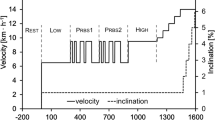Abstract
This study investigated the change in the energetically optimal cadence after prolonged cycling. The energetically optimal cadence (EOC) was determined in 14 experienced cyclists by pulmonary gas exchange at six different cadences (100–50 rpm at 10 rpm intervals). The determination of the EOC was repeated after a prolonged cycling exercise of 55 min duration, where cadence was fixed either at high (>95 rpm) or low (<55 rpm) pedalling rates. The EOC decreased after prolonged cycling exercise at a high as well as at a low fixed cadence (P < 0.01). According to the generalized muscle equations of Hill, this indicates that most likely more type I muscle fibres contribute to muscular power output after fatiguing cycling exercise compared to cycling in the beginning of an exercise bout. We suggest that the determination of EOC might be a potential non-invasive method to detect the qualitative changes in activated muscle fibres, which needs further investigation.





Similar content being viewed by others
References
Aaron EA, Seow KC, Johnson JA, Dempsey BD (1992) Oxygen cost of exercise hyperpnea: implications for performance. J Appl Physiol 72:1818–1825
Ahlquist LE, Bassett DR, Sufit R, Nagle DP, Thomas FJ (1992) The effect of pedaling frequency on glycogen depletion rates in type I and type II quadriceps muscle fibers during submaximal cycling exercise. Eur J Appl Physiol 65:360–364
Altenburg TM, Degens H, van Mechelen W, Sargeant A, de Haan AJ (2007) Recruitment of single muscle fibers during submaximal cycling exercise. J Appl Physiol 103:1752–1756
Argentin S, Hausswirth C, Bernard T, Bieuzen F, Leveque JM, Couturier A, Lepers R (2006) Relation between preferred and optimal cadences during two hours of cycling in triathletes. Br J Sports Med 40:293–298
Borg G (1982) Ratings of perceived exertion and heart rates during short-term cycle exercise and their use in a new cycling strength test. Int J Sports Med 3:153–158
Bottinelli R, Reggiani C (2000) Human skeletal muscle fibres: molecular and functional diversity. Prog Biophys Mol Biol 73:195–262
Brisswalter J, Hausswirth C, Smith D, Vercruyssen F, Vallier JM (2000) Energetically optimal cadence vs. freely-chosen cadence during cycling: effect of exercise duration. Int J Sports Med 21:60–64
Chavarren J, Calbet JAL (1999) Cycling efficiency and pedaling frequency in road cyclists. Eur J Appl Physiol 80:555–563
Coast JR, Welch HG (1985) Linear increase in optimal pedal rate with increased power output in cycle ergometry. Eur J Appl Physiol 53:339–342
Di Prampero PE (2000) Cycling on earth, in space, on the moon. Eur J Appl Physiol 82:345–360
Farina D, Macaluso A, Ferguson RA, de Vito G (2004) Effect of power, pedal rate, and force on average muscle fiber conduction velocity during cycling. J Appl Physiol 97:2035–2041
Foss O, Hallén J (2004) The most economical cadence increases with increasing workload. Eur J Appl Physiol 92:443–451
Francescato MP, Girardis M, di Prampero PE (1995) Oxygen cost of internal work during cycling. Eur J Appl Physiol 72:51–57
Gonzalez-Alonso J, Calbet JAL, Nielsen B (1998) Muscle blood flow is reduced with dehydration during prolonged exercise in humans. J Physiol 513:895–905
Hagberg JM, Mullin JP, Nagle FJ (1978) Oxygen consumption during constant-load exercise. J Appl Physiol 45:381–384
Hansen EA, Andersen JL, Nielsen JS, Sjogaard G (2002) Muscle fibre type, efficiency, and mechanical optima affect freely chosen pedal rate during cycling. Acta Physiol Scand 176:185–194
Henneman E, Somjen G, Carpenter DO (1965) Functional significance of cell size in spinal motoneurons. J Neurophysiol 28:560–580
Hill AV (1938) The heat of shortening and the dynamic constants of muscle. Proc Royal Soc Lond 126:136–195
Hill AV (1964) The effect of load on the heat of shortening of muscle. Proc Royal Soc Lond 159:297–318
Kohler G, Boutellier U (2004) Glycogen reduction in non exercising muscle depends on blood lactate concentration. Eur J Appl Physiol 92:548–554
Kohler G, Boutellier U (2005) The generalized force–velocity relationship explains why the preferred pedaling rate of cyclists exceeds the most efficient one. Eur J Appl Physiol 94:188–195
Martin JC, Brown NA, Anderson FC, Spirduso WW (2000) A governing relationship for repetitive muscular contraction. J Biomech 33:969–974
Passfield L, Doust JH (2000) Changes in cycling efficiency and performance after endurance exercise. Med Sci Sports Exerc 32:1935–1941
Patterson RP, Moreno MI (1990) Bicycle pedalling forces as a function of pedalling rate and power output. Med Sci Sports Exerc 22:512–516
Poole DC, Gaesser GA, Hogan MC, Knight DR, Wagner PD (1992) Pulmonary and leg \( \dot{V}{\text{O2}}\max \) during submaximal exercise: implications for muscular efficiency. J Appl Physiol 72:805–810
Sarre G, Lepers R (2005) Neuromuscular function during prolonged pedalling exercise at different cadences. Acta Physiol Scand 185:321–328
Vercruyssen F, Hausswirth C, Smith D, Brisswalter J (2001) Effect of exercise duration on optimal pedaling rate choice in triathletes. Can J Appl Physiol 26:44–54
Wakeling JM (2009) Patterns of motor recruitment can be determined using surface EMG. J Electromyogr Kinesiol 19:199–207
Widrick JJ, Freedson PS, Hamill J (1992) Effect of internal work on the calculation of optimal pedaling rates. Med Sci Sports Exerc 24:376–382
Zuntz N (1901) Ueber die Bedeutung der verschiedenen Nährstoffe als Erzeuger der Muskelkraft. Pflügers Arch Physiol 83:557
Acknowledgments
We thank Dr. Ruth Briggs for commenting and revising the manuscript. The experiments comply with the current laws of Switzerland.
Conflict of interest statement
The authors declare that they have no conflict of interest.
Author information
Authors and Affiliations
Corresponding author
Additional information
Communicated by Susan Ward.
Rights and permissions
About this article
Cite this article
Annaheim, S., Boutellier, U. & Kohler, G. The energetically optimal cadence decreases after prolonged cycling exercise. Eur J Appl Physiol 109, 1103–1110 (2010). https://doi.org/10.1007/s00421-010-1431-9
Accepted:
Published:
Issue Date:
DOI: https://doi.org/10.1007/s00421-010-1431-9




